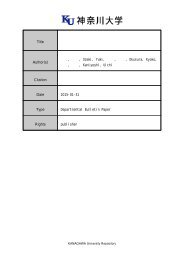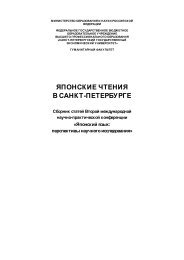to Learners with Special Educational Needs
e-textbook SEN
e-textbook SEN
Create successful ePaper yourself
Turn your PDF publications into a flip-book with our unique Google optimized e-Paper software.
Pokrivčáková, S. et al. (2015). Teaching Foreign Languages <strong>to</strong> <strong>Learners</strong> <strong>with</strong> <strong>Special</strong> <strong>Educational</strong> <strong>Needs</strong>:<br />
e-textbook for foreign language teachers. Nitra: Constantine the Philosopher University. 128 p.<br />
ISBN 978-80-558-0941-0<br />
The types of problems experienced in<br />
reading might be:<br />
• hesitant and laboured reading, especially<br />
out loud;<br />
• confusing letters such as b-d, m-n, p-d, u-n<br />
and those that sound similarly – in Slovak<br />
language s-y, k-g, š-ž;<br />
• in Slovak language – ignoring the soft or<br />
hard syllables – de-te-ne-le-di-ti-ni-li;<br />
• omitting or adding extra words;<br />
• reading at a reasonable rate, but <strong>with</strong> low<br />
level of comprehension;<br />
• failure <strong>to</strong> recognise familiar words;<br />
• missing a line or reading the same line<br />
twice;<br />
• losing the place or using a finger or marker<br />
<strong>to</strong> keep the place;<br />
• double reading (silent reading first and<br />
then aloud)<br />
• difficulty in pinpointing the main idea in a<br />
passage;<br />
• finding difficulty in using dictionaries,<br />
direc<strong>to</strong>ries and encyclopaedias.<br />
The types of problems experienced in<br />
writing might be:<br />
• poor standard of written work<br />
compared <strong>to</strong> oral ability;<br />
• poor handwriting <strong>with</strong> badly formed<br />
letters;<br />
• good handwriting, but production of<br />
work is extremely slow;<br />
• badly set out work <strong>with</strong> spellings<br />
crossed out several times;<br />
• words spelled differently in one piece of<br />
work;<br />
• difficulty <strong>with</strong> punctuation and<br />
grammar;<br />
• confusion of upper- and lower-case<br />
letters;<br />
• writing a great deal but ‘loses the<br />
thread’;<br />
• writing very little but <strong>to</strong> the point;<br />
• difficulty in taking notes in lessons;<br />
• difficulty in organising work and<br />
personal timetable.<br />
The mindmap below summarises some of the symp<strong>to</strong>ms of dyslexia that might be observed.<br />
Figure 1: Dyslexia Difficulties Mind Map (Source: Teaching resources homepage; 2013)<br />
Bakker (1990, in Pumfrey & Reason, 2005) has hypothesized the existence of two types of<br />
dyslexia “P” (perceptual) type and “L” (linguistic) type. “P” type learners “tend <strong>to</strong> read<br />
relatively slowly and in a fragmented fashion, albeit rather accurately because they remain<br />
42






